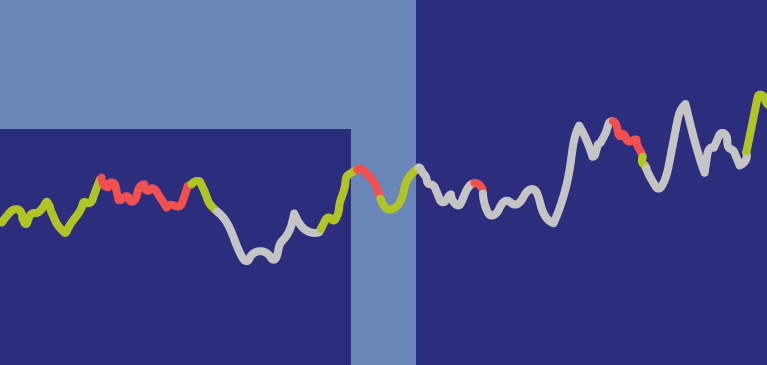by Erik Ristuben, Russell Investments
Is there a path upward for markets this year?
Much has been made in the news recently about the possible onset of the next recession—and rightfully so, in our opinion, as we believe the next economic downturn is a matter of when, not if. In fact, we peg the odds of a U.S. recession by the end of 2020 at roughly 67%. In other words, a negative economic event looks increasingly likely to us in the not-too-distant future. Yet, in the short term, we think there’s a less than one-in-three draw—a 29% probability, per our Business Cycle Index (BCI) forecasting model—that a recession will hit in the next twelve months.
Therein lies the rub: An economic slump is probably on the way, but not imminently so. It’s no question that concern over when such a storm will hit shore contributed to much of the dizzying descent for markets last quarter—and while January kicked off the new year with meaningful gains, we don’t see volatility going away any time soon. That said, we do see a way forward through the gathering storm clouds—but it will likely require looking for opportunities outside the U.S.
U.S. forecast for 2019: A bumpy ride
Simply put, we expect U.S. equities to have their fair share of struggles in 2019—not unlike the fourth quarter of 2018, when America took the brunt of a plunging stock market. While weak performance was the name of the game across the board last October through December, U.S. markets sold off significantly more than their non-U.S. counterparts, especially in the emerging markets sector.1
Why? In our opinion, it all boiled down to valuations. U.S. equities, in our view, were extremely expensive heading into Q4—inflated by lofty expectations. By contrast, emerging market equities—while not wildly cheap—were nowhere near as costly, having already been beaten up by a host of monetary crises in places like Argentina and Turkey.
Fast forward three months, and the picture still looks mostly the same to us today: Pricey U.S. equities, and comparatively cheaper options elsewhere—in spite of the broad market selloff. This, in our view, underscores just how extraordinarily expensive the U.S. market was during the bulk of 2018: Last quarter’s ugliness bumped U.S. equity valuations down to merely the really expensive range.
In short, because we still see valuations as quite high—just not stratospheric—we think that the troubles for U.S. stocks are far from over this year. That’s not to say that 2019 will play out to the same tune as last quarter—i.e., with stomach-churning drops and a narrow bear-market miss. However, we think movements in markets will largely be driven by whether or not expectations are met.
While the fundamental data itself is still important—i.e., a GDP (gross domestic product) growth rate of 3% during Q2 would be nothing to sneeze at—how it stacks up to market expectations is what’s likely to matter most. It doesn’t help the case for the U.S. that baked into these expectations are lofty numbers from 2018: a GDP growth rate of 4.2% in Q2 and 3.4% in Q3.2 Last year’s earnings growth numbers are even more mind-boggling for so late in the market cycle: 25% in Q1, 24% in Q2 and 26% in Q3.3
These numbers, in our view, are largely resultant from the fiscal and tax policies enacted by Congress in late 2017 and early 2018. The Tax Cuts and Jobs Act, for instance, helped turbo-charge earnings growth for the simple reason that many corporations footed a smaller tax bill, allowing them to hold on to more revenue. Likewise, the spending package authorized by Congress in February 2018 propelled the U.S. economy to new highs—with average growth rates through the first three quarters of the year roughly double what the country experienced from 2014-2017.4
Expectations in flux
As we all know, the upward climb for U.S. equities soured in a hurry last quarter when reality began to set in: Earnings growth rates probably weren’t going to be in the 20% range in 2019, and economic growth rates would likely take a hit as well. To wit, as we head further into the new year, we foresee growth cooling off to an approximately 2% clip by the end of Q2—a halving of the country’s GDP on a year-over-year basis, with negative growth rates potentially looming in the not-too-distant future. Earnings-wise, we think single digits are probably the limit for U.S. equities—another sharp fall-off from last year.
It goes without saying that we’re far from alone in this thinking, as market expectations have been slowly ratcheted down ever since last fall. However, it’s the uncertainty in what’s realistic for 2019 that the market continues to struggle with. Will U.S. growth slow to 2%—or dip even lower? When could the economy contract? What does the bottom of the market look like in 2019? With expectations unclear, we see the bar to achieving outperformance in the U.S. market as significantly higher this year.
Europe: An easier bar to meet?
The opposite appears true outside the U.S. Across Europe, Japan and the emerging markets sector, for instance, we think expectations have already been lowered enough to the point where they can be exceeded. Concerns over Brexit, China, trade wars, the Italian budget crisis and a slew of other issues, such as natural disasters in Japan, have led to sagging investor confidence in these regions—too pessimistic of an outlook, in our opinion.
Take Europe, for starters. Earnings-per-share growth has been strikingly similar to the U.S. over roughly the last four years, while the dividend yield from 2014-2018 in Europe has actually been meaningfully higher.5 So, why the lower returns over the past several years? The difference is almost entirely due to the fact that multiples—better known in the U.S. as price-to-earnings ratios—have expanded in the U.S., while contracting in Europe. This is likely due, in large part, to ongoing political and financial worries: Before Brexit and Italy were dominating headlines, German elections, the Greek bailout and the Portuguese debt crisis were keeping investors up at night. Put another way, with 19 countries comprising the eurozone, there’s usually always something to worry about in Europe.
Yet, it’s important to realize that countries aren’t stocks. Over the past five years, European corporations have done just as well as their U.S. counterparts, both in terms of earnings growth and dividend yield—they just didn’t get paid for it. This, in a nutshell, is one of our base arguments for why we expect non-U.S. stocks to outperform U.S. stocks in the years ahead: We think that the multiples that have expanded in dramatic fashion in the U.S. will soon shrink, whereas contracted multiples in Europe will soon go the other way.
Japan: The bar is low
We see opportunities for outperformance in Japan as well, again due to the level of expectations. In our view, growth expectations in Japan are extraordinarily modest, relative to the rest of the world. This is primarily because of Japan’s negative demographic picture—the country’s population shrank by nearly 400,000 in 2017 as deaths outnumbered births.6 This makes maintaining positive growth of any kind a significant challenge, hence Abenomics—the series of policy reforms spearheaded by Prime Minister Shinzo Abe to boost the country’s economy.
A key part of this approach is quantitative easing. Essentially, the Central Bank of Japan has a mandate to prevent deflation, which makes Japanese monetary policy highly accommodative. This, in turn, typically spells a positive environment for stocks—one reason why we like an allocation to Japan. In addition, the country has placed a newfound emphasis on increasing shareholder value, which, in our minds, increases the potential for unlocking valuations.
China and emerging markets: Better times ahead?
It’s no secret that ramifications of the ongoing trade conflict between the U.S. and China have spilled over to the emerging markets sector, especially to China itself. The Shanghai Composite Index, after all, was down roughly 30% from a 52-week high last month, placing it firmly in bear market territory.7 The pain has been felt even sharper by the Chinese economy, which logged its slowest growth rate since 1990 last quarter at 6.6%.
In our view, this damage will result in the Chinese government really going all-in on fiscal stimulus—with Beijing giving every indication it will do just that as of late. Why? Recent history demonstrates there’s a fairly low threshold for unemployment in China before civil unrest starts bubbling to the surface. This leads us to conclude that there’s a high probability China stabilizes its growth rate this year, somewhere to the tune of 6%. In our minds, this means that Chinese growth has probably already reached a low point for the year. Going forward, on a relative basis, we anticipate the situation to improve. Again, because the bar of expectations has been significantly lowered, we think there’s a path forward for Chinese markets and, more broadly, emerging markets as a whole—given that China is the world’s largest emerging-market economy.
The wrap
The past several years have largely been smooth sailing for U.S. investors, as earnings and growth expectations were typically met or exceeded. But the sharp market selloff last quarter shows that the era of fair seas may be coming to an end, as still-lofty expectations confront the twin threats of a cooling U.S. economy and diminishing corporate earnings. Ultimately, we see valuations as more attractive in Europe, Japan and emerging markets, where dampened expectations point to potential for better opportunities in the year ahead.
1 Source: S&P 500® Index, MSCI Emerging Markets Index, STOXX® Europe 600 Index
2 Source: https://www.bea.gov/media/3531
3 Source: FactSet, based on S&P 500® Index: https://www.factset.com/hubfs/Resources%20Section/Research%20Desk/Earnings%20Insight/EarningsInsight_122118.pdf
5 Source: U.S. Equity: S&P 500® Index; Europe: MSCI Europe Index. Dates: Nov. 2014-Sept. 2018
6 Source: https://www.businessinsider.com/japans-population-is-shrinking-demographic-time-bomb-2018-6
Copyright © Russell Investments















